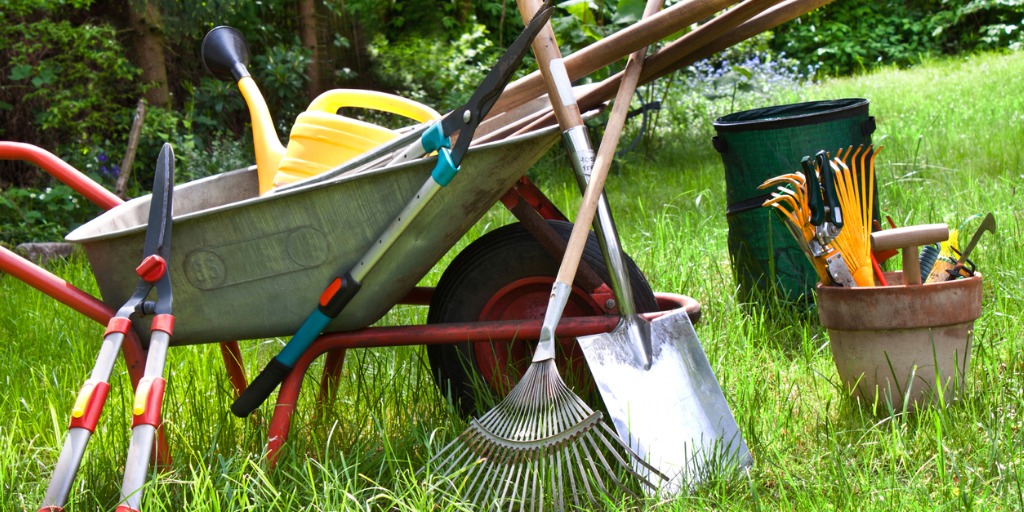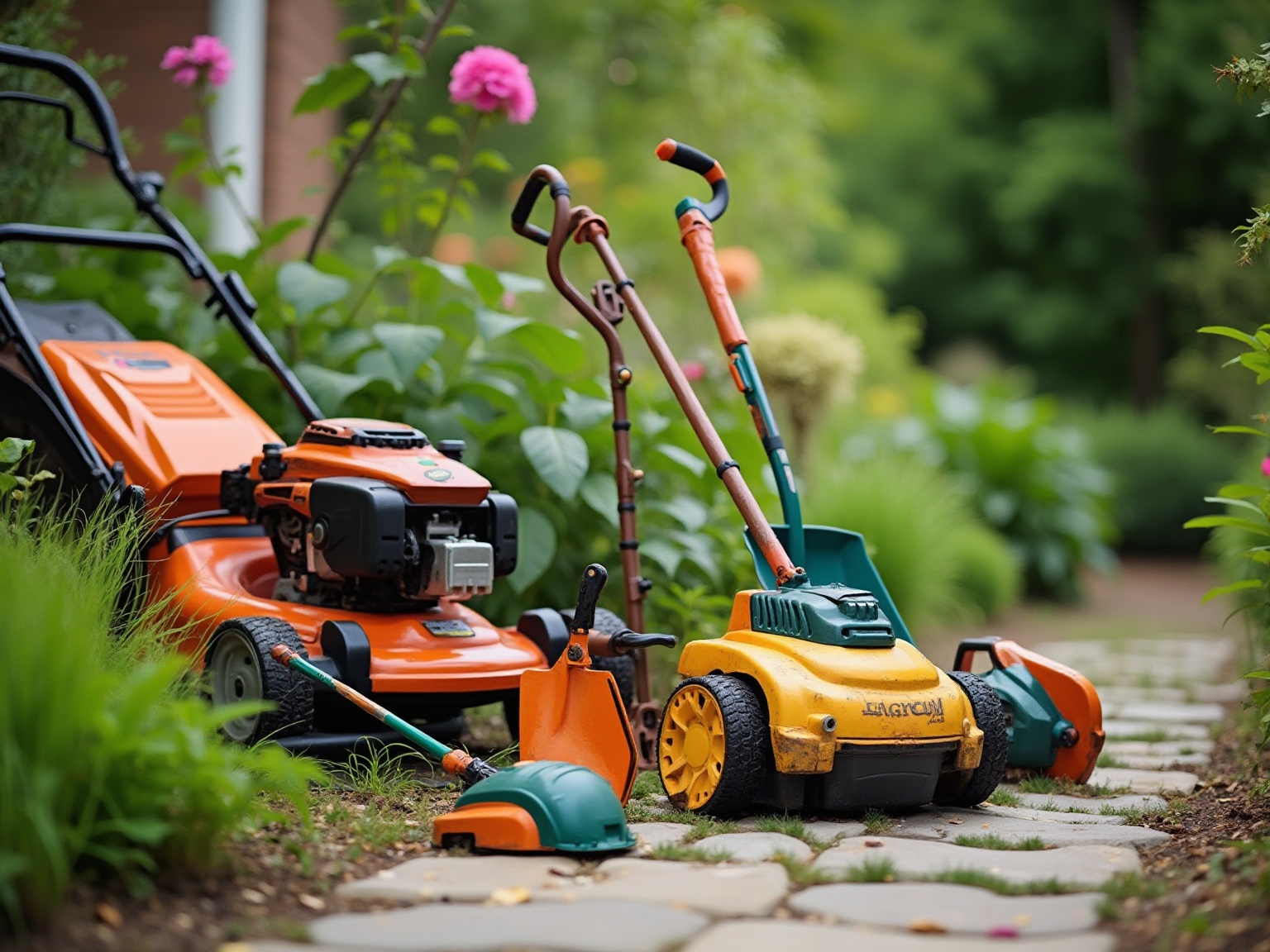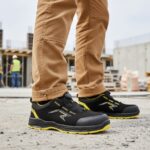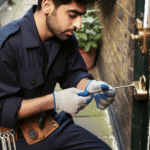The U.S. has more than half a million landscaping businesses. Picking the right heavy landscaping equipment is a vital way to stand apart from competitors. Caterpillar has influenced how professionals choose their equipment since 1925.
Modern landscaping equipment goes beyond traditional choices. Today’s machines pack impressive features. Skid steers work perfectly in confined spaces. Telehandlers can lift materials higher than 55 feet. This piece will help you understand and pick the right landscaping equipment for your business.
Your business needs the right tools to move forward. We’ll look at versatile backhoe loaders that handle multiple tasks and specialized dump trucks that transport materials. This knowledge will help you make smart equipment decisions for your company’s growth.

Understanding the Core Types of Landscaping Equipment
Landscaping professionals must know their equipment’s strengths and limits to boost productivity on job sites. Picking the right machinery can make or break a project and help avoid pricey delays or rework.
Skid steers vs. compact track loaders
Skid steers and compact track loaders do similar jobs but work differently on terrains of all types. Skid steers work best on hard, flat surfaces like concrete, asphalt, and pavement because of their wheel design and zero-radius turning ability. These machines are light enough to tow behind a standard pickup truck.
Compact track loaders spread their weight evenly through rubber tracks. This makes them perfect for soft, wet, or uneven terrain where wheels might sink or damage surfaces. The tracks give better grip and stability on muddy, snowy, or sandy ground without damaging turf.
Here’s what you need to know about speed and stability:
- Skid steers move faster on flat surfaces and turn better in tight spaces
- Track loaders work better on uneven surfaces even though they’re slower
- Skid steers need less upkeep since wheels are easier to maintain than tracks
Both machines work with many attachments for digging, grading, and material handling. This makes them valuable tools in any landscaping equipment collection.
When to use backhoes, dozers, and excavators
Backhoe loaders combine three machines—a loader, tractor, and backhoe—into one versatile unit. These machines are great for projects that need both digging and material transport. The front loader moves materials while the rear backhoe digs trenches, holes, and foundations. Medium to large landscaping jobs need backhoes to handle bigger material loads, but they need more space to work.
Dozers come with a large metal blade that pushes huge amounts of soil, sand, and gravel. You’ll use them to:
- Clear large land areas
- Create slopes and berms
- Grade terrain
- Push materials across job sites
Their wide rotating twin tracks spread weight evenly, so they can work on soft ground without sinking. Dozers come in different sizes to match your project needs.
Excavators, especially mini and small hydraulic models, give you precision for detailed work in tight spaces. They can turn 360 degrees, which makes them perfect for digging trenches, planting trees, installing water features, and hardscaping. Mini excavators like the 300.9D can fit through shoulder-width spaces between buildings or along retaining walls.
Specialty equipment: telehandlers, dump trucks, and water trucks
Telehandlers work like crane-forklift hybrids with extendable booms that reach impressive heights. They lift and place heavy items like boulders, large plants, and construction supplies in tough spots. On top of that, they help with tree care by reaching high limbs for pruning and removal. Their strong frames and tough wheels handle rough terrain well, and various attachments make them even more useful.
Dump trucks are crucial for moving loose materials like soil, gravel, sand, and demolition debris. They haul away dug-up material and bring in total materials using hydraulic lifts for unloading. Many landscapers rent these vehicles based on job needs instead of buying them.
Water trucks play several key roles in landscaping:
- Control dust on job sites for safety and environmental compliance
- Help with soil compaction by adding moisture
- Water large plant areas and keep soil moist during planting
- Supply water for irrigation and fill ponds or water features
These trucks usually carry 2,000 to 6,000 gallons of water to keep sites visible and plants hydrated throughout projects.
This guide to equipment types helps you build the right landscaping equipment list based on your projects and terrain challenges.

Choosing the Right Equipment for Your Business Needs
Your landscaping business’s success starts with smart equipment choices. The right heavy landscaping machinery will streamline your operations and boost your service capabilities.
Assessing project size and frequency
Your typical projects should guide your equipment decisions. Small-scale projects that take a day or two with minimal machinery work well with compact equipment like mini excavators or skid steers. Projects of medium to large scale will take five or more days and call for bigger machinery.
Here are the main factors to think over before you buy:
- Frequency of use: Daily or weekly use makes high-quality, commercial-grade investment worthwhile
- Property size: Larger properties or commercial spaces will need machines with better capacity
- Seasonal considerations: Some equipment might sit idle during off-seasons, so renting could be smarter
Your typical job requirements will tell you if you need specialized machinery. Tasks like reshaping flowerbeds, regrading lawns, or handling large trees and shrubs need more than simple tools.
Residential vs. commercial landscaping demands
Commercial and residential projects come with different equipment needs. Commercial landscaping usually involves bigger properties that just need specialized machinery for extensive work.
Commercial properties typically require:
- Heavy-duty, industrial-grade mowers, tractors, and excavators to manage large green spaces
- Bigger teams with specialized training to handle complex landscapes
- Equipment that can handle intricate irrigation systems and extensive hardscaping
Residential landscaping works better with smaller, versatile equipment. Mini excavators and skid steer loaders are great for tight spaces and leave lighter footprints that reduce soil and turf damage.
The cost difference is notable. Commercial landscaping costs more because of its scale, equipment needs, and maintenance requirements. In fact, some commercial businesses hire residential services for smaller tasks to cut costs.
Matching equipment to service offerings
Your equipment list should line up with your services to maximize returns. Experience shows that versatile machines are crucial—fewer machines are needed when each one can handle multiple tasks.
To match equipment with services:
- For lawn care services: Get reliable mowers that fit your property sizes, plus edgers and trimmers for details
- For landscape maintenance: You’ll need hand tools, spreaders, shears, and specific equipment to plant, weed, and control pests
- For hardscaping and construction: Look at heavier machinery like backhoe loaders, excavators, and dozers
Skid steer loaders are valuable because they work with many attachments. One machine can dig, grade, handle materials, and more with the right attachments. The coupler might be your most important piece of landscaping equipment since it lets operators switch attachments quickly.
Note that your equipment needs will grow with your business. Start with versatile machines that handle multiple jobs. Let your operational data guide your expansion and new equipment purchases. This approach ensures your machinery investments meet current needs while supporting future growth.
Attachments That Maximize Equipment Value
You can expand your heavy landscaping equipment capabilities without buying more machines by choosing the right attachments. These attachments turn simple equipment into versatile workhorses that increase your return on investment and help your team handle projects of all types.
Top attachments for digging, cutting, and clearing
The right attachments for your landscaping machinery create a more flexible fleet that handles multiple tasks efficiently. Here are the most valuable attachments professional landscapers need:
Mulchers and brushcutters are great at managing vegetation. Mulchers turn overgrowth into usable mulch through different configurations, while brushcutters use metal blades to cut through small tree trunks and dense weeds. Drum mulchers handle trees 4-7 inches in diameter and make land clearing operations quick and easy.
Augers give you the drilling power you need for post-hole digging and tree planting. These attachments work with skid steers, backhoe loaders, and excavators to speed up installation of fencing, decks, and trees.
Buckets are the foundations of any landscaping equipment list. You’ll find stump buckets for tearing out stumps, rock buckets for filtering debris, and grapple buckets that secure bulky materials during transport. A 4-in-1 bucket lets operators scoop, grade, doze, and dump with a single attachment.
Stump grinders take the hassle out of manual stump removal by turning stumps into mulch you can use elsewhere on properties. Landscape tillers prepare seedbeds by mixing and breaking up soil to create the best planting conditions.
How couplers and quick-change systems improve efficiency
Quick couplers are state-of-the-art tools that maximize heavy landscaping equipment efficiency. Operators can switch between attachments in seconds instead of spending up to 20 minutes on manual changes.
Here’s why they’re such a big deal:
Safety improvements protect workers because operators stay in the cab during attachment changes, which reduces exposure to risks. Visual and audible indicators confirm proper connections throughout operations.
Productivity gains happen as machines become true multi-taskers. Hydraulic connecting couplers link to your machine’s hydraulics and electronics, so you get immediate functionality without leaving the cab. This feature is especially valuable when projects need multiple tools.
Cost reduction comes from quick couplers making attachments work between similarly-sized machines. You won’t need to buy dedicated attachments for each piece of equipment in your fleet.
Quick-change systems also include maintenance-friendly features like easily accessible primary grease points that make routine service simple. These serviceability features add even more value beyond operational efficiency.
Buy or Rent? Making the Smart Investment
financing or renting heavy landscaping equipment is one of the biggest financial decisions your landscaping business will face. Your choice will affect your cash flow, operational flexibility, and long-term profitability.
At the time renting makes more sense
Renting landscaping machinery works best in specific situations. New businesses with limited capital can reduce upfront costs by renting equipment, which frees up money for other essential expenses. The numbers show that rental is budget-friendly if you use equipment less than 65% of the time—this helps measure your decision.
Space plays a crucial role too. Your business might lack adequate storage for large equipment, so renting solves this issue. Many landscapers rent specialized equipment like stump grinders, compressors, and aerators for seasonal or specific project needs.
Renting lets your team try equipment before buying. You can assess performance and fit before making a major investment.
Long-term benefits of owning equipment
Equipment ownership builds equity and wealth over time—something you’ll never get with rentals. You’ll have equipment ready whenever needed, and won’t worry about shortages during peak seasons.
Buying makes sense if regular use pays for the equipment within two to three years. Companies with steady contracts and good maintenance programs often get more value from ownership.
Equipment financing gives you affordable monthly payments and helps build business credit through timely payments. These financing plans might also offer tax benefits through interest payment deductions.
Cost comparison: upfront vs. lifecycle
Total Cost of Ownership (TCO) helps assess the full cost of buying, operating, and maintaining equipment throughout its lifetime. This method splits costs into two groups:
Direct costs cover purchase price, installation, routine maintenance, and financing expenses. Indirect costs are harder to spot but include productivity losses during downtime, training expenses, and missed opportunities.
Renting costs more long-term than ownership but eliminates maintenance work and upfront investment. The final choice depends on your business’s needs, financial health, and growth plans.
Equipment you use regularly often provides better value through purchase—though financing might help manage cash flow better than buying outright.
Scaling Your Equipment Fleet as You Grow
Landscaping businesses that are scaling up face tough decisions about their equipment fleet. Smart planning and data analysis help you make better choices about machinery investments.
How to prioritize new equipment purchases
Your landscaping equipment list needs careful thought about current and future needs. The best way to prioritize starts with looking at how you use your equipment. You should replace machines that run at full capacity first, especially when repair costs start eating into profits.
Most landscaping pros put their money into essential equipment first. Your specialty tools can come later as the business grows. Here are key factors to think about when buying new equipment:
- Operational impact: Put your money first into machines that boost productivity or help you offer more services
- Maintenance records: Keep tabs on repair frequency to spot equipment that’s reaching its end
- Customer demands: Buy equipment that your clients ask for regularly
- Seasonal requirements: Find the right mix between year-round and seasonal equipment
Equipment that’s well-maintained gives you better results. Setting up proper cleaning, maintenance, and storage procedures helps your equipment last longer. Regular maintenance checks also stop unexpected breakdowns that can mess up project schedules and hurt client relationships.
Using data to guide expansion decisions
Modern fleet management turns operational data into smart business moves. Telematics systems watch how teams use vehicles and equipment to help prevent accidents and damage. Industry experts say telematics gives you a clear picture of your fleet and lets you track your business and machines better.
This formula helps you compare costs when looking at new equipment: Cost to rebuild (new equipment price x .5)/equipment life (estimated hours x .75) = cost per hour. The numbers tell you whether it’s better to replace or rebuild.
Digital vehicle and equipment checks let you handle issues as they happen. Automatic alerts about upcoming maintenance sent to operators and technicians help keep equipment running. Detailed records help predict how machines will perform and what they’ll cost to run, including work hours, fuel use, and maintenance costs.
The digital world keeps changing, so it’s smart to buy equipment with telematics features. These tools reduce downtime, make job sites more efficient, and help you make smarter choices as you grow.
Conclusion
Choosing the right heavy landscaping equipment is a vital decision that determines business success. My field experience shows that skid steers or compact track loaders serve as versatile core machines and provide the strongest foundation. These workhorses combined with strategic attachments help businesses handle a variety of projects while keeping costs in check.
Equipment decisions require thorough analysis of your specific needs. Project frequency, property types, and service offerings need evaluation before any purchase commitments. Modern telematics systems make use of information to optimize equipment usage and maintenance schedules effectively.
Your equipment strategy should grow alongside your business. Renting works well for specialized or seasonal needs, while ownership proves more affordable for machines you keep using. Quality and reliability should top your priority list because downtime ultimately costs more than premium equipment.






